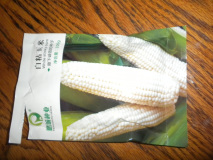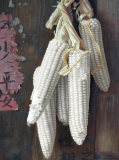- Store
- >
- CORN, non-GMO, Zea mays
- >
- Asian Waxy Corn
- >
- 25 White Asian Waxy Sticky Sweet Corn seeds, China
25 White Asian Waxy Sticky Sweet Corn seeds, China
SKU:
$3.98
$3.98
Unavailable
per item
90 days. Original seed stock grown in China. High-gluten, waxy sweet corn. Rare.
Separate from other corns by 200 yards. Grow separate from other corns. Standard corn growing protocols. Takes about 2-3 months to maturity and about 6 ft. tall.
Hard kernels must be boiled 30 minutes or more.
A brief History of Asian Waxy Corn
Corn, or maize, was a hybrid plant developed year after year by pre-historic humans who grew it from fields of natural grass called teosinte. Scientists believe that corn was developed by the native peoples living in Central America (now Mexico) between 7,000 and 10,000 years ago where it became a dietary staple. Colored Indian corn and corn parts are often used in native religious ceremonies. Sweet Indian corn is traditionally used for pinole (roasted and reconstituted), or is picked early and tender then fresh-boiled.
At some point in early human history, American corn was carried to Asia, where many centuries of intentional breeding developed a genetically different variety of maize than its American cousin.
Asian Waxy corn (glutinous maize) was "discovered" by Westerners in China in 1909. This variety of corn showed many peculiar traits when examined by scientists. In 1922 a researcher found that the endosperm of waxy maize contained only amylopectin and no amylose starch molecules, in contrast to all other dent corn varieties that normally contain both starches.
Until World War II, the main source of starch in the USA was tapioca imported from Japan, but during WWII American food processors were forced to turn to waxy corn for food production. Amylopectin or waxy starch is used mainly in food products, as well as in the textile, adhesive, and paper industries.
NOTE: Ears from waxy corn must be boiled for 30 minutes or more to soften the dense, hard kernels.
DO NOT grow Waxy Corn within 200 yards of American sweet corn or cross-pollination will make proper kernel cooking impossible.
Corn, or maize, was a hybrid plant developed year after year by pre-historic humans who grew it from fields of natural grass called teosinte. Scientists believe that corn was developed by the native peoples living in Central America (now Mexico) between 7,000 and 10,000 years ago where it became a dietary staple. Colored Indian corn and corn parts are often used in native religious ceremonies. Sweet Indian corn is traditionally used for pinole (roasted and reconstituted), or is picked early and tender then fresh-boiled.
At some point in early human history, American corn was carried to Asia, where many centuries of intentional breeding developed a genetically different variety of maize than its American cousin.
Asian Waxy corn (glutinous maize) was "discovered" by Westerners in China in 1909. This variety of corn showed many peculiar traits when examined by scientists. In 1922 a researcher found that the endosperm of waxy maize contained only amylopectin and no amylose starch molecules, in contrast to all other dent corn varieties that normally contain both starches.
Until World War II, the main source of starch in the USA was tapioca imported from Japan, but during WWII American food processors were forced to turn to waxy corn for food production. Amylopectin or waxy starch is used mainly in food products, as well as in the textile, adhesive, and paper industries.
NOTE: Ears from waxy corn must be boiled for 30 minutes or more to soften the dense, hard kernels.
DO NOT grow Waxy Corn within 200 yards of American sweet corn or cross-pollination will make proper kernel cooking impossible.



